汽车专业英语 教案Unit 4New Energy Vehicle
- 格式:doc
- 大小:98.00 KB
- 文档页数:5
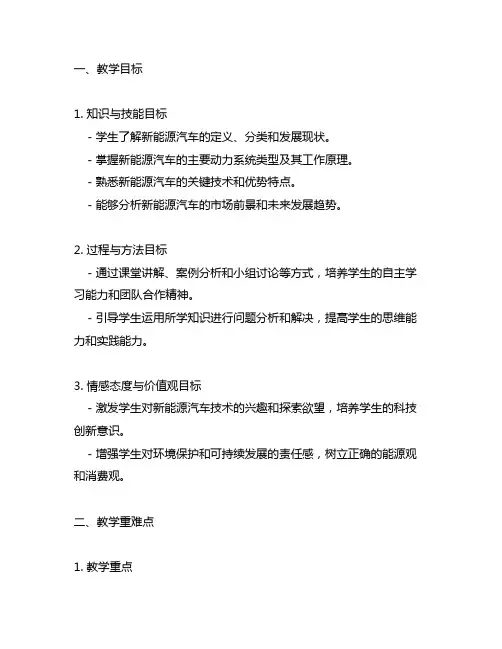
一、教学目标1. 知识与技能目标- 学生了解新能源汽车的定义、分类和发展现状。
- 掌握新能源汽车的主要动力系统类型及其工作原理。
- 熟悉新能源汽车的关键技术和优势特点。
- 能够分析新能源汽车的市场前景和未来发展趋势。
2. 过程与方法目标- 通过课堂讲解、案例分析和小组讨论等方式,培养学生的自主学习能力和团队合作精神。
- 引导学生运用所学知识进行问题分析和解决,提高学生的思维能力和实践能力。
3. 情感态度与价值观目标- 激发学生对新能源汽车技术的兴趣和探索欲望,培养学生的科技创新意识。
- 增强学生对环境保护和可持续发展的责任感,树立正确的能源观和消费观。
二、教学重难点1. 教学重点- 新能源汽车的定义、分类和发展现状。
- 新能源汽车的主要动力系统类型及其工作原理。
- 新能源汽车的关键技术和优势特点。
2. 教学难点- 新能源汽车动力系统的工作原理理解。
- 新能源汽车市场前景和未来发展趋势的分析。
三、教学方法1. 讲授法- 讲解新能源汽车的基本概念、发展历程和关键技术等理论知识。
- 运用多媒体课件、图片、视瓶等教学资源,增强教学的直观性和趣味性。
2. 案例分析法- 选取典型的新能源汽车案例进行分析,引导学生深入思考新能源汽车的应用和发展。
- 通过案例分析,培养学生的问题解决能力和实践应用能力。
3. 小组讨论法- 将学生分成小组,围绕新能源汽车的相关问题进行讨论和交流。
- 培养学生的团队合作精神和表达能力。
4. 实践教学法- 安排学生参观新能源汽车展厅或相关企业,实地了解新能源汽车的实际应用情况。
- 增强学生对新能源汽车的感性认识和实践操作能力。
四、教学过程1. 导入(5 分钟)- 通过播放一段新能源汽车的宣传视瓶或展示一些新能源汽车的图片,引起学生的兴趣,导入本节课的主题——新能源汽车。
- 提问学生:你们对新能源汽车有哪些了解?或者你们在日常生活中有没有见过新能源汽车?激发学生的思考和讨论。
2. 新能源汽车的定义、分类和发展现状(20 分钟)- 教师讲解新能源汽车的定义,强调新能源汽车是指采用新型动力系统,完全或主要依靠新型能源驱动的汽车。
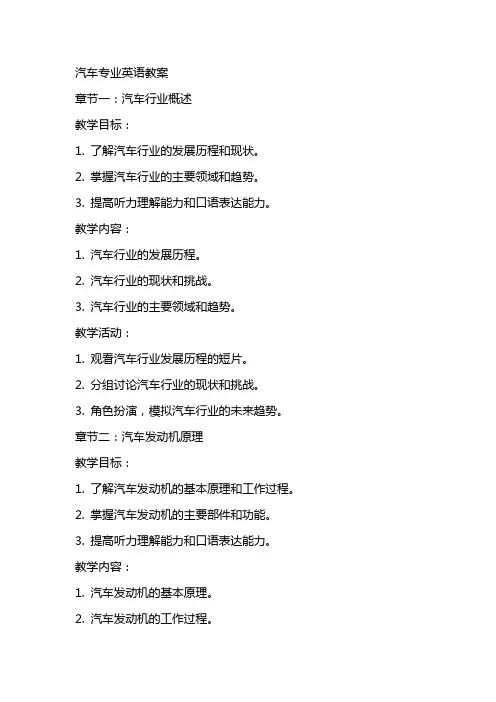
汽车专业英语教案章节一:汽车行业概述教学目标:1. 了解汽车行业的发展历程和现状。
2. 掌握汽车行业的主要领域和趋势。
3. 提高听力理解能力和口语表达能力。
教学内容:1. 汽车行业的发展历程。
2. 汽车行业的现状和挑战。
3. 汽车行业的主要领域和趋势。
教学活动:1. 观看汽车行业发展历程的短片。
2. 分组讨论汽车行业的现状和挑战。
3. 角色扮演,模拟汽车行业的未来趋势。
章节二:汽车发动机原理教学目标:1. 了解汽车发动机的基本原理和工作过程。
2. 掌握汽车发动机的主要部件和功能。
3. 提高听力理解能力和口语表达能力。
教学内容:1. 汽车发动机的基本原理。
2. 汽车发动机的工作过程。
3. 汽车发动机的主要部件和功能。
教学活动:1. 观看汽车发动机工作原理的演示。
2. 分析汽车发动机的主要部件和功能。
3. 小组讨论,总结汽车发动机的工作过程。
章节三:汽车电气系统教学目标:1. 了解汽车电气系统的基本原理和组成。
2. 掌握汽车电气系统的主要部件和功能。
3. 提高听力理解能力和口语表达能力。
教学内容:1. 汽车电气系统的基本原理。
2. 汽车电气系统的组成和主要部件。
3. 汽车电气系统的工作过程和功能。
教学活动:1. 观看汽车电气系统工作原理的演示。
2. 分析汽车电气系统的主要部件和功能。
3. 小组讨论,总结汽车电气系统的工作过程。
章节四:汽车transmission 系统教学目标:1. 了解汽车transmission 系统的基本原理和类型。
2. 掌握汽车transmission 系统的主要部件和功能。
3. 提高听力理解能力和口语表达能力。
教学内容:1. 汽车transmission 系统的基本原理。
2. 汽车transmission 系统的类型和特点。
3. 汽车transmission 系统的主要部件和功能。
教学活动:1. 观看汽车transmission 系统工作原理的演示。
2. 分析汽车transmission 系统的主要部件和功能。
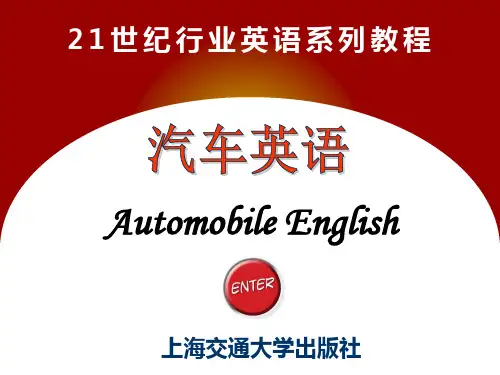

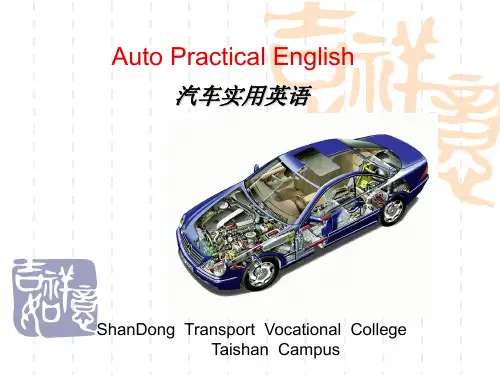
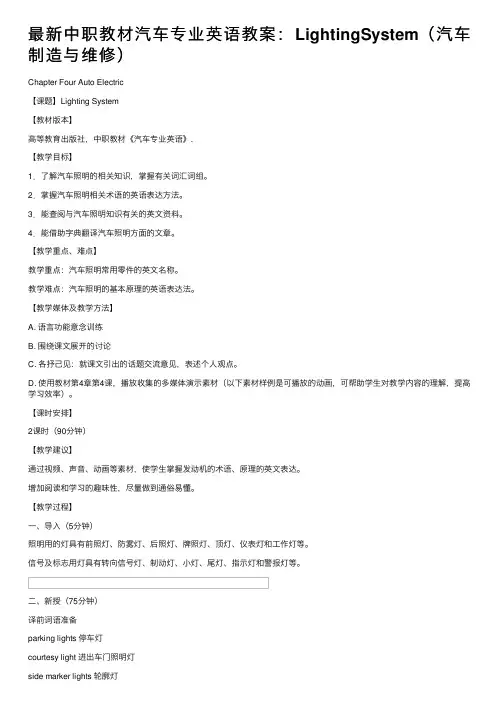
最新中职教材汽车专业英语教案:LightingSystem(汽车制造与维修)Chapter Four Auto Electric【课题】Lighting System【教材版本】⾼等教育出版社,中职教材《汽车专业英语》.【教学⽬标】1.了解汽车照明的相关知识,掌握有关词汇词组。
2.掌握汽车照明相关术语的英语表达⽅法。
3.能查阅与汽车照明知识有关的英⽂资料。
4.能借助字典翻译汽车照明⽅⾯的⽂章。
【教学重点、难点】教学重点:汽车照明常⽤零件的英⽂名称。
教学难点:汽车照明的基本原理的英语表达法。
【教学媒体及教学⽅法】A. 语⾔功能意念训练B. 围绕课⽂展开的讨论C. 各抒⼰见:就课⽂引出的话题交流意见,表述个⼈观点。
D. 使⽤教材第4章第4课,播放收集的多媒体演⽰素材(以下素材样例是可播放的动画,可帮助学⽣对教学内容的理解,提⾼学习效率)。
【课时安排】2课时(90分钟)【教学建议】通过视频、声⾳、动画等素材,使学⽣掌握发动机的术语、原理的英⽂表达。
增加阅读和学习的趣味性,尽量做到通俗易懂。
【教学过程】⼀、导⼊(5分钟)照明⽤的灯具有前照灯、防雾灯、后照灯、牌照灯、顶灯、仪表灯和⼯作灯等。
信号及标志⽤灯具有转向信号灯、制动灯、⼩灯、尾灯、指⽰灯和警报灯等。
⼆、新授(75分钟)译前词语准备parking lights 停车灯courtesy light 进出车门照明灯side marker lights 轮廓灯license plate light 牌照灯low beam 近光high beam 远光译⽂及评析Your new "Sealed Beam" headlights are easy to maintain. All you need to do is occasionally wipe off the outside of the lens. Checking the aim periodically is also a good safety practice. In the event of accidental damage or burning out, the entire headlight unit can be easily replaced by your car dealer.新式的“封闭式灯芯”前照灯很容易进⾏维护。
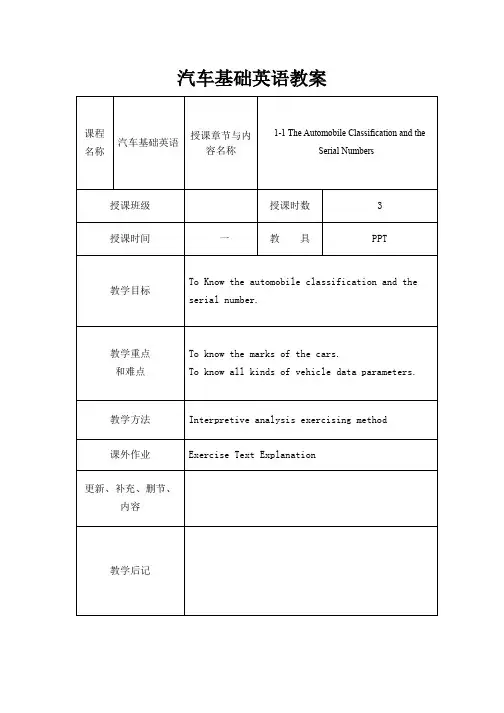
汽车基础英语教案课堂教学安排(续表)数据信息。
这些资料对用户使用汽车和维修汽车都会有很大帮助。
II. Diagram1.The key dimension data of a vehicle2.performance parameters of the total vehicle(1)full speed(2)specific fuel consumption(3)maximum climbing ability(4)min radius of turn(5)engine capacity(6)compression ratio(7)engine torque(8)engine powerIII. Example of the vehicle specification chart P131. complete vehicle kerb mass整车整备质量2. maximum total mass 最大总质量3. maximum pay最大装置重量4. maximum axle mass 最大轴质量(/mæs/质量)5. vehicle length 车长6.Vehicle width 车宽7.Vehicle height车高8.Wheelbase轴距(/'wi:lbeis/)9.track(tread)轮距10.Front overhang 前悬11.Rear overhang 后悬理论课教案(首页)课堂教学安排(续表)III. key words1 electrical window lifter switch 电动车窗玻璃升降器开关2 center control lock button 中央集控「]锁按钮3 internal spanner 内开扳手4 rearview mirror regulator tap 后视镜调节开关5 vent 出风☐6 light switch 灯光开关7 turn indicator telltale, dimming lever and continuous control system switch 转向信号灯、变光拨杆和巡航控制系统开关8 dashboard lighting control rotary knob 仪表盘照明调节旋钮9 air bag 安全气囊10 clustered instrument board 组合式仪表盘理论课教案(首页)课堂教学安排(续表)I.Prior Knowledge (预备知识)There are various gauges and indicators on the dashboard, from which the drivers can know how the vehicle and the system work. So as to ensure the vehicle to work safely and regularly. The dash- board differs on different vehicles, containing different contents, but the shape and the indicating meanings of the gauges and indicators are approximately the same.【参考译文】在汽车驾驶室的仪表板上装有各种指示仪表及指示灯,驾驶员可通过这些仪表和指示灯随时了解车辆及各系统的工作情况,保证车辆安全正常地运行。
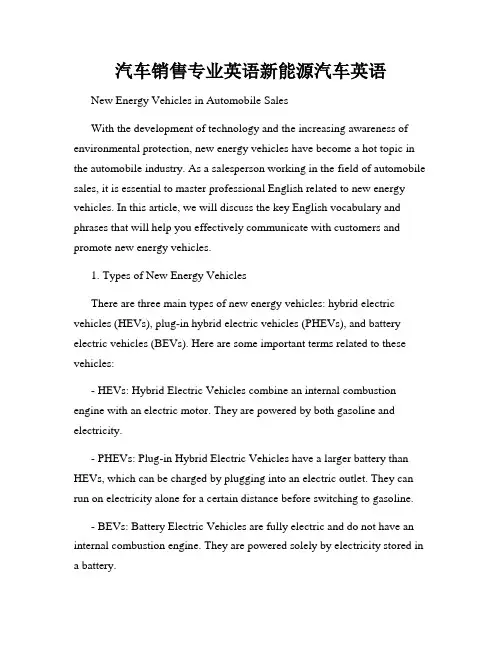
汽车销售专业英语新能源汽车英语New Energy Vehicles in Automobile SalesWith the development of technology and the increasing awareness of environmental protection, new energy vehicles have become a hot topic in the automobile industry. As a salesperson working in the field of automobile sales, it is essential to master professional English related to new energy vehicles. In this article, we will discuss the key English vocabulary and phrases that will help you effectively communicate with customers and promote new energy vehicles.1. Types of New Energy VehiclesThere are three main types of new energy vehicles: hybrid electric vehicles (HEVs), plug-in hybrid electric vehicles (PHEVs), and battery electric vehicles (BEVs). Here are some important terms related to these vehicles:- HEVs: Hybrid Electric Vehicles combine an internal combustion engine with an electric motor. They are powered by both gasoline and electricity.- PHEVs: Plug-in Hybrid Electric Vehicles have a larger battery than HEVs, which can be charged by plugging into an electric outlet. They can run on electricity alone for a certain distance before switching to gasoline.- BEVs: Battery Electric Vehicles are fully electric and do not have an internal combustion engine. They are powered solely by electricity stored in a battery.2. Charging InfrastructureOne of the challenges for the widespread adoption of new energy vehicles is the availability of charging infrastructure. Here are some key terms related to charging:- EV Charging Station: A facility where electric vehicles can be charged. It can be a public charging station or a private one at home.- Fast Charging: A type of charging that allows for a quicker charge, usually within 30 minutes to an hour.- Range Anxiety: The fear of running out of battery power before reaching a charging station. It is a common concern among electric vehicle owners.3. Incentives and SubsidiesMany governments around the world offer incentives and subsidies to promote the adoption of new energy vehicles. Here are some terms related to these policies:- Electric Vehicle Tax Credit: A tax credit given to consumers who purchase an electric vehicle. It helps reduce the cost of the vehicle.- Rebate: A cash incentive given to consumers after purchasing an electric vehicle. It is a form of financial support.- Zero-Emission Vehicle (ZEV) Mandate: A regulation that requires automakers to produce a certain percentage of zero-emission vehicles. It aims to reduce vehicle emissions and promote clean transportation.4. Environmental BenefitsNew energy vehicles are known for their environmental benefits, including lower greenhouse gas emissions and reduced air pollution. Here are some terms related to the environmental impact of new energy vehicles:- Carbon Footprint: The total amount of greenhouse gases emitted directly and indirectly by a product, organization, or individual. New energy vehicles have a lower carbon footprint compared to traditional gasoline vehicles.- Clean Energy: Energy from renewable sources that do not produce greenhouse gas emissions, such as solar, wind, and hydroelectric power. New energy vehicles contribute to the use of clean energy.In conclusion, mastering professional English related to new energy vehicles is essential for automobile sales professionals. By understanding and using the key vocabulary and phrases discussed in this article, you will be able to effectively communicate with customers, promote new energy vehicles, and contribute to the sustainable development of the automobile industry.。
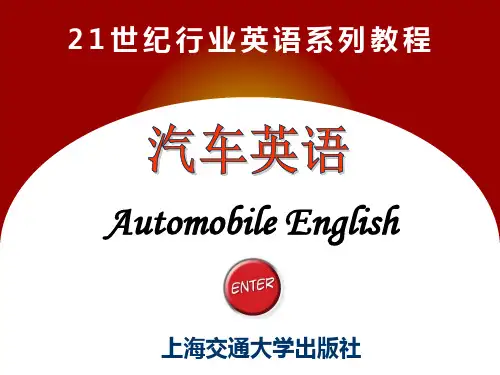
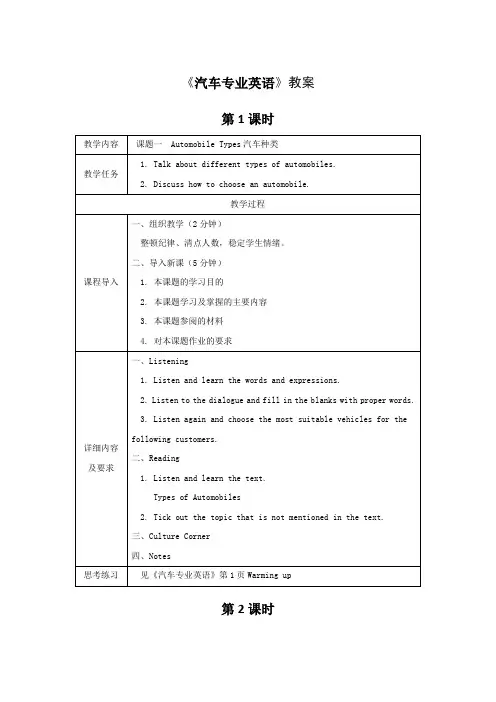
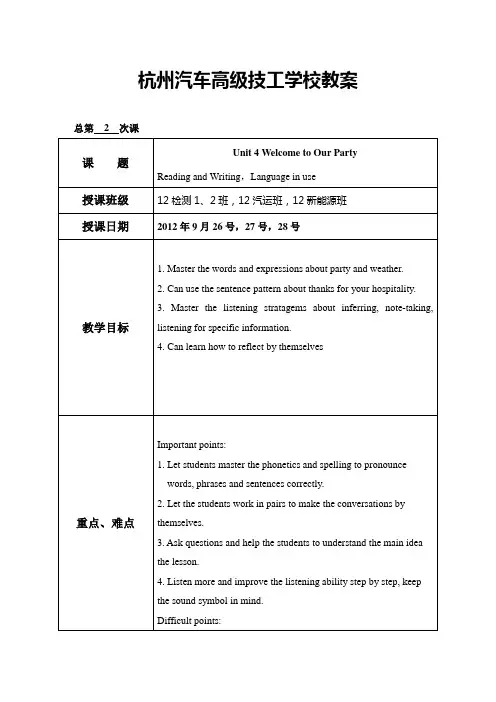
Unit 1 Development History of AutomobileExercises1. Questions to the Text.1) How many stages have the birth of the car experienced?The birth of the car have experienced three stages.2) Who invented the internal combustion engine?In 1866, Count Nicholas Otto put forward the famous working cycle theory of internal combustion engine, namely "Otto cycle".3) Which country is the birthplace of modern cars?Germany is the birthplace of modern cars.4) What is the new direction for the development of automotive applications?New energy, especially electric energy, has become the most likely application development direction of automotive industry in recent years.2. Translate the Following Words into Chinese.1) ve hicle 汽车2) environment 环境3) standardized 标准化4) enterprise 公司5) monopoly垄断6) electric energy电能3. Translate the Following Sentences into Chinese.1) In 21 Century, human beings are facing more serious problems such as resource shortage, energy shortage, and environmental pollution and so on. Energy conservation, environmental protection and safety have become the eternal theme of the development of the automobile industry.进入21世纪,人类面临着资源短缺、能源短缺、环境污染等更为严重的问题。
新能源汽车专业英语新能源汽车专业英语一、概述New energy vehicles (NEVs) are a type of vehicle that uses alternative energy sources, such as electricity, hydrogen fuel cells, or hybrid systems. They are becoming increasingly popular due to their environmental benefits and potential cost savings.二、电动汽车Electric vehicles (EVs) use electric motors powered by rechargeable batteries. They emit no tailpipe pollutants and have lower operating costs than traditional gasoline-powered cars. Types of EVs include battery electric vehicles (BEVs), plug-in hybrid electric vehicles (PHEVs), and hybrid electric vehicles (HEVs).三、燃料电池汽车Fuel cell vehicles (FCVs) use hydrogen gas to power an electric motor. The only emissions from FCVs are water vapor and heat. However, the infrastructure for producing and distributing hydrogen is still limited.四、混合动力汽车Hybrid electric vehicles combine an internal combustion engine with an electric motor to improve fuel efficiency and reduce emissions. There are two types of HEVs: series hybrids, where the engine charges the battery which powers the motor; parallel hybrids, where both the engine and motor can drive the wheels.五、充电基础设施Charging infrastructure is essential for EVs to be practical for daily use. This includes public charging stations at parking lots, shopping centers, etc., as well as home charging units installed in garages or driveways.六、政策支持和市场前景Many governments around the world offer incentives such as tax credits orrebates for purchasing NEVs in order to promote their adoption. The market outlook for NEVs is positive due to increasing concerns about climate change and air pollution, as well as advancements in technology making them more affordable and practical for consumers.七、未来发展趋势The future development trend of NEV industry will focus on improving battery technology to increase range while reducing costs; expanding charging infrastructure; developing new materials that can make lighter weight cars with longer ranges; exploring new business models such as car sharing services using NEV fleets; integrating smart technologies into NEV systems like autonomous driving features etc..。
新能源汽车英文课程设计一、课程目标知识目标:1. 学生能掌握新能源汽车的基本英文术语,如“electric vehicle”, “plug-in hybrid”, “battery capacity”等;2. 学生能理解并描述新能源汽车的主要类型、工作原理及优缺点;3. 学生能运用英文讨论新能源汽车对环境的影响及未来发展趋势。
技能目标:1. 学生能通过阅读英文资料,获取新能源汽车相关信息,提高阅读理解能力;2. 学生能运用英文进行口头讨论和报告,提高口语表达和交流能力;3. 学生能通过写作,如撰写短文或日记,表达自己对新能源汽车的看法和建议。
情感态度价值观目标:1. 学生对新能源汽车产生兴趣,培养环保意识和可持续发展观念;2. 学生通过学习新能源汽车相关知识,认识到科技创新对改善环境的重要性;3. 学生能够积极参与到新能源汽车话题的讨论中,树立积极的价值观和责任感。
课程性质:本课程为英语学科拓展课程,结合新能源汽车热点,提高学生英语实际应用能力。
学生特点:六年级学生,具有一定的英语基础,好奇心强,善于表达,对新鲜事物有较高的兴趣。
教学要求:结合学生特点,采用互动式、任务驱动式教学,注重培养学生的英语实际应用能力和综合素质。
在教学过程中,关注学生的学习成果,及时调整教学策略,确保课程目标的实现。
二、教学内容本课程内容依据课程目标,紧密结合英语教材中相关章节,组织以下教学内容:1. 新能源汽车基本概念:- 介绍“electric vehicle”, “plug-in hybrid”等基本术语;- 分析新能源汽车与传统燃油车的区别。
2. 新能源汽车类型及工作原理:- 分类介绍纯电动汽车、混合动力汽车、燃料电池汽车等;- 详细解释各类新能源汽车的工作原理。
3. 新能源汽车优缺点:- 分析新能源汽车的环保优势、经济优势;- 探讨新能源汽车在续航里程、充电设施等方面的局限性。
4. 新能源汽车与环境:- 讨论新能源汽车对减少碳排放、改善空气质量的作用;- 分析新能源汽车在未来可持续发展中的地位。
新能源汽车new energy vehicleChina has released a guideline to encourage the consumption of new energy vehicles(NEVs) to promote high-quality development of the sector and form a strong domestic market. 我国发布指导方案鼓励新能源汽车销售,促进该行业高质量发展,形成强大的国内市场。
【名词解释】新能源汽车(new energy vehicles,NEVs)指采用新型动力系统,完全或主要依靠新型能源驱动的汽车,具有能耗低(low energy consumption)、污染物排放少(low pollutant emission)等特点,主要包括插电式混合动力汽车(plug-in hybrid electric vehicle,简称PHEV)、纯电动汽车(battery electric vehicles ,简称BEV)和燃料电池汽车(fuel-cell electric vehicles)。
方案提出,严禁各地出台新的汽车限购规定,坚决破除乘用车消费障碍。
各地应大力推动新能源汽车消费使用,不得对新能源汽车实行限行、限购(local governments are strictly prohibited from imposing any limit on the consumption and use of NEVs),已实行的应当取消。
方案还提出鼓励地方对无车家庭购置首辆家用新能源汽车给予支持(support for the purchase of first NEVs of car-free families),鼓励有条件的地方在停车费等方面给予新能源汽车优惠等。
此外,方案也提出了大幅降低新能源汽车成本(lower the cost ofNEVs production)、稳步推动智能汽车创新发展(promote innovative development of smart vehicles)、持续提升汽车节能环保性能(increase energy efficiency)等方面的内容。